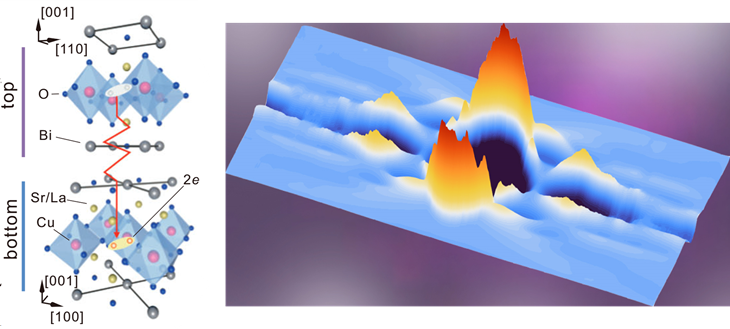New experiment on twisted cuprate sheds light on the enigmatic nature of pairing
2023/08/30
On August 25th, the high-temperature superconductivity group of BAQIS/Tsinghua University, led by Prof. Ding Zhang and Prof. Qi-Kun Xue, reported their study on Josephson tunneling in twisted Bi2Sr2-xLaxCuO6+y (Bi-2201) system in Nature Communications. This work further challenges the recently proposed exotic pairing and corroborates the group's previous finding of an isotropic pairing in the twisted cuprate system.
Superconductivity has attracted broad interest, thanks to the recent discoveries of novel superconductors. Despite these progresses, the record holder for the highest superconducting temperature at ambient pressure is still the cuprate compound, which was discovered nearly four decades ago. Understanding the mechanism of superconductivity in cuprates is therefore vital for guiding the research on new record-breaking materials. This goal has been pursued by the BAQIS/Tsinghua group for many years. The group has been developing a unique technique to address the pairing symmetry—a fundamental property of any superconductors. By readapting the modern technique of van der Waals stacking to their special needs, the group pioneered in fabricating twisted cuprate Josephson junctions with atomically flat interfaces and well-controlled angle.It allows them to gain direct access to the phase component of the superconducting wave function [Y. Zhu, et al., Physical Review X 11, 031011 (2021)]. The initial work has triggered rapid developments in both theory and experiment of this field. In the recent two years, several theoretical groups proposed an exotic pairing in the platform developed by the BAQIS/Tsinghua group. It was further expected that Majorana zero energy mode could be achieved in this twisted bilayer system, raising hope for seeing this enigmatic phenomenon at a temperature as high as the boiling point of nitrogen. It therefore becomes urgently necessary to experimentally test these theoretical proposals.
To test the new proposals requires highly uniform Josephson junctions. For a Josephson junction, the key parameter that governs its homogeneity is the Josephson penetration depth. However, it is only a few hundred nanometers in Bi2Sr2CaCu2O8+x (Bi-2212), the material that was formerly employed by the BAQIS/Tsinghua group. This length in Bi-2212 is much shorter than the actual size of the sample. To solve this problem, the group chose Bi-2201 single crystals grown by Xingjiang Zhou’s Group from Institute of Physics, Chinese of the Academy of Sciences (IOP, CAS). Bi-2201 possesses single copper oxide planes and the Josephson penetration depth can be as long as several micrometers, an order of magnitude greater than that of Bi-2212. The group then developed specific nanofabrication recipe and achieved devices with the lateral size comparable to the Josephson penetration depth. They further designed and constructed an in situ piezo-driven rotator for precisely aligning the junction parallel to the magnetic field.
All these efforts paid off and the group became able to carry out a stringent test of the new theory. They obtained a modulated critical current with the applied magnetic field, which follows closely the standard formula for the Fraunhofer diffraction pattern. Notably, the researchers also observed the AC Josephson effect due to the electromagnetic resonance of the junction. This effect manifests itself as discrete voltage steps in the current-voltage characteristics. The appearance voltage steps up to the fifth level unambiguously indicates that the device is of supreme quality. This is further substantiated by the structural analysis carried out by the transmission electron microscopy (TEM) groups of Prof. Jing Zhu and Prof. Lin Gu in Tsinghua University. Importantly, the data allows the group to check the theoretical proposal from three different aspects: the temperature evolution of tunneling current, the Fraunhofer pattern, and the AC Josephson effect. They found that all three experimental features are incompatible with the predictions based on the new theory. Instead, the experiments give further support to the core discovery of the group’s former study. Namely, there exists an isotropic pairing component in the twisted cuprate Josephson junction.
The paper, entitled “Prominent Josephson tunneling between twisted single copper oxide planes of Bi2Sr2-xLaxCuO6+y”, was published in Nature Communications. The first author is Dr. Heng Wang (former PhD student in Tsinghua University). The corresponding authors are Dr. Yuying Zhu of BAQIS, Prof. Ding Zhang and Prof. Qi-Kun Xue of Tsinghua University/ BAQIS. Other collaborators included PhD candidates Zhonghua Bai (Tsinghua) and Shuxu Hu (Tsinghua), Dr. Xiaopeng Hu (Tsinghua), Dr. Zechao Wang (former PhD student in Tsinghua), Prof. Lin Gu (Tsinghua), Prof. Jing Zhu (Tsinghua). Jian Cui (BAQIS), Miaoling Huang (BAQIS), Prof. Hongyi Xie (BAQIS), Prof. Jianhao Chen (Peking University/BAQIS), Dr. Ying Ding (IOP, CAS), Dr. Xinyan Li (IOP, CAS), Prof. Lin Zhao (IOP, CAS), Prof. Qinghua Zhang (IOP, CAS) and Prof. Xingjiang Zhou (IOP, CAS). This work was financially supported by the National Natural Science Foundation of China (NSFC), Ministry of Science and Technology (MOST) of the People’s Republic of China, the Beijing Natural Science Foundation, and the State Key Laboratory of Low-Dimensional Quantum Physics of Tsinghua University.

Left:Schematic structure of the twisted junction. Right:Typical Fraunhofer pattern that was experimentally measured from a twisted Josephson junction.
Article Links: https://rdcu.be/dkohp
 中文
中文 Email
Email QCloud
QCloud Log in
Log in
